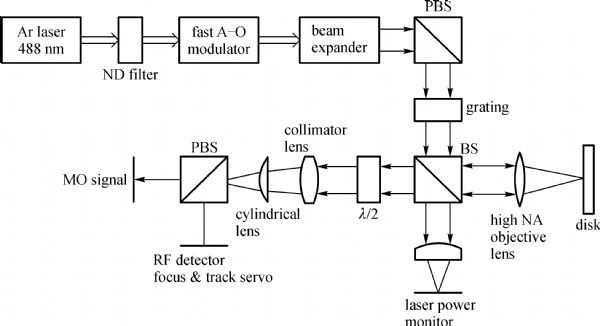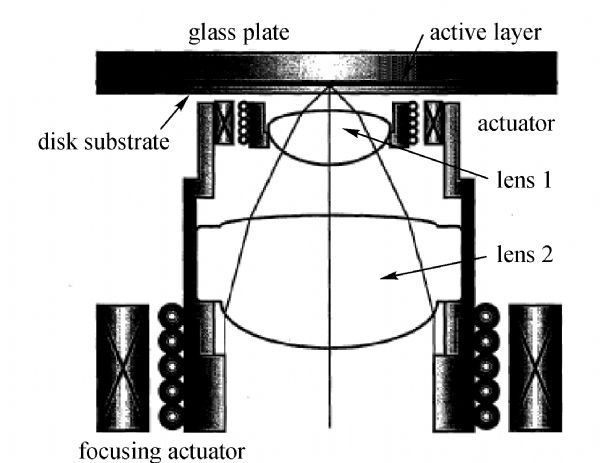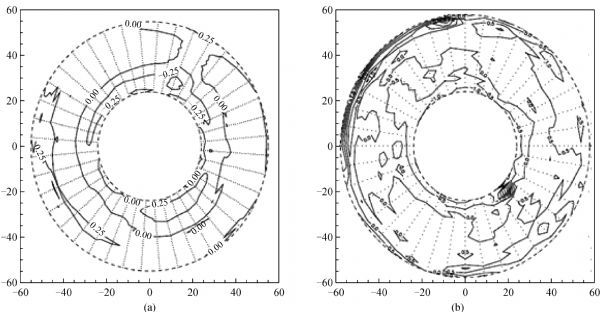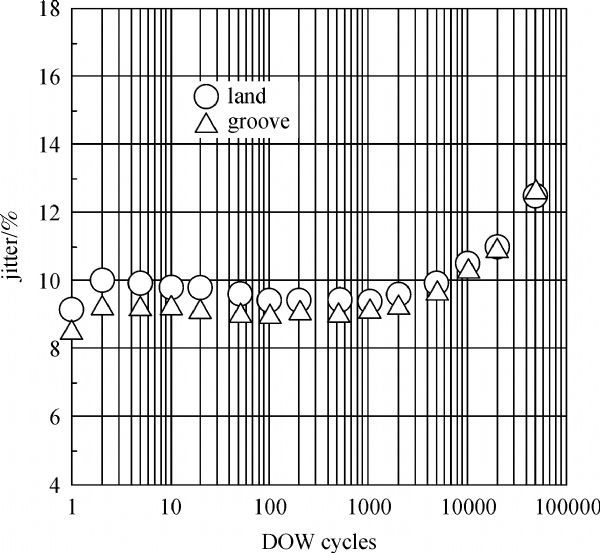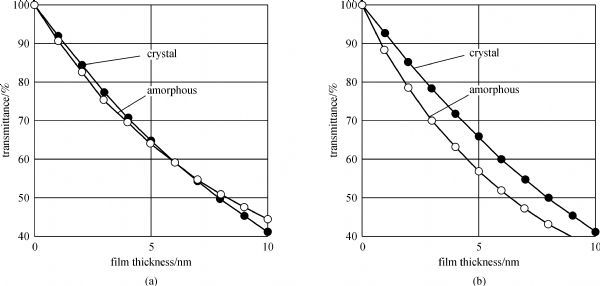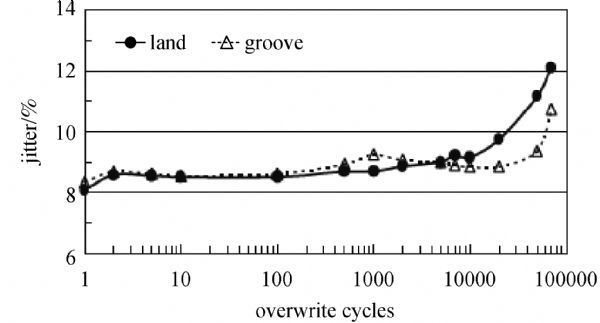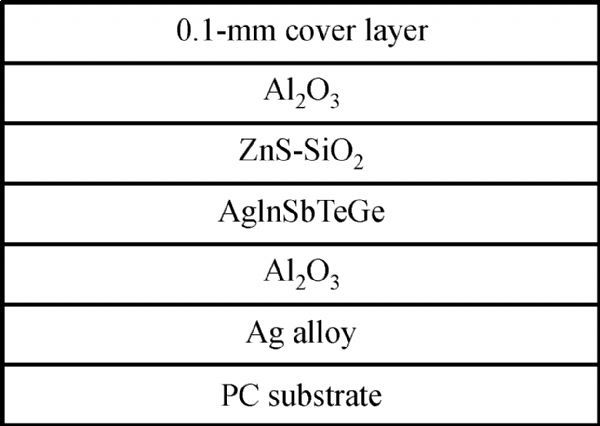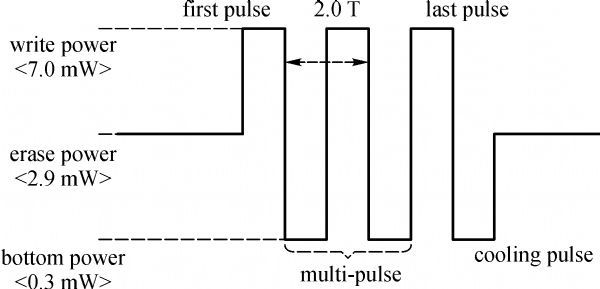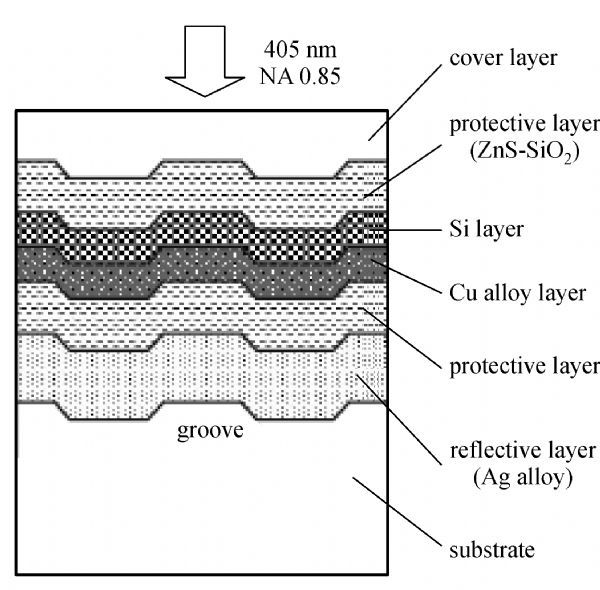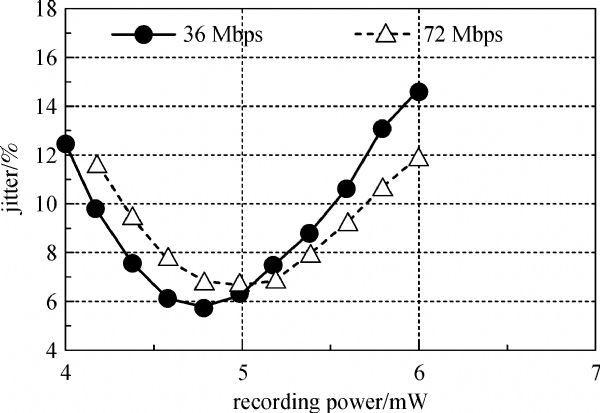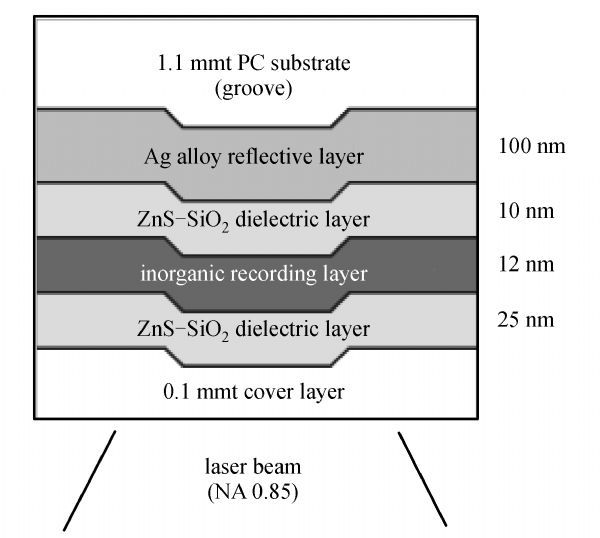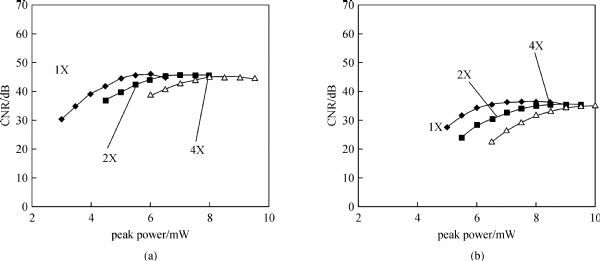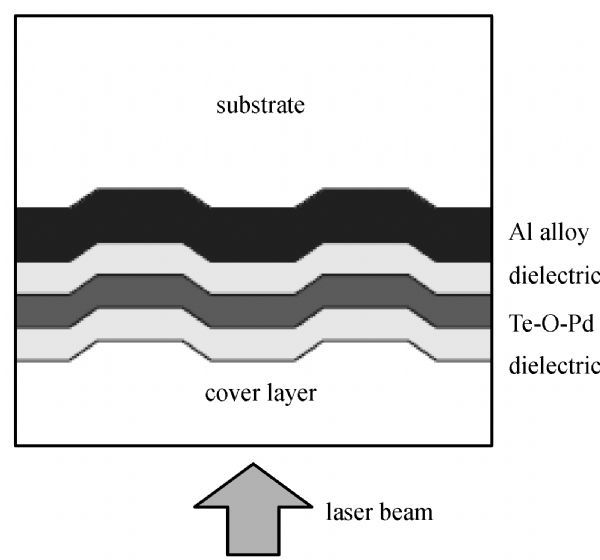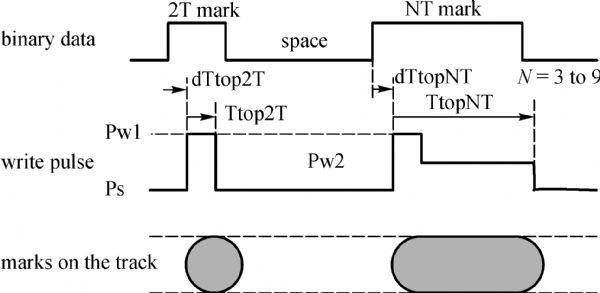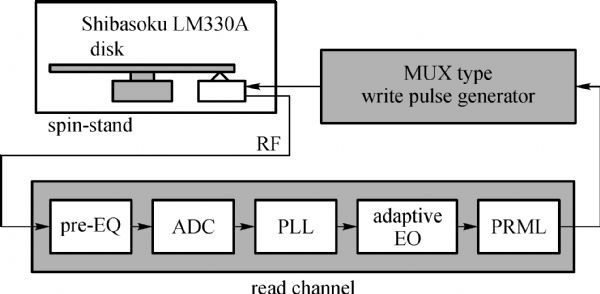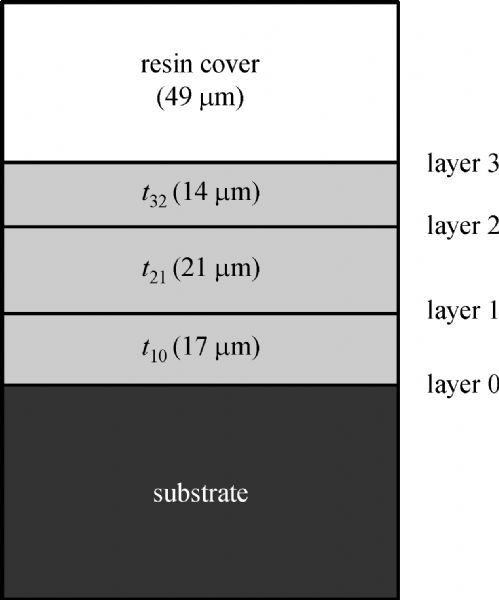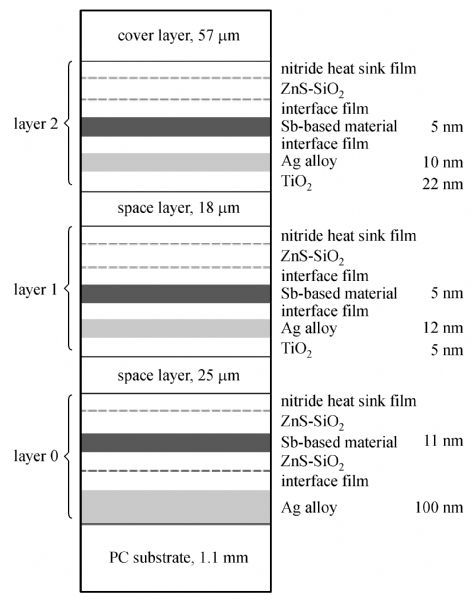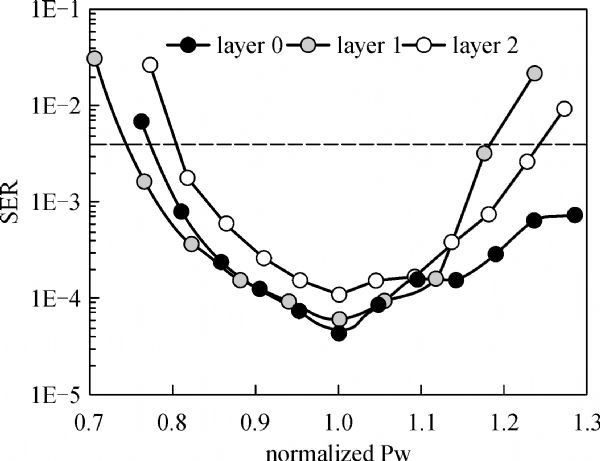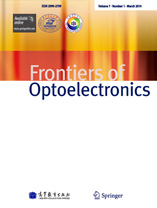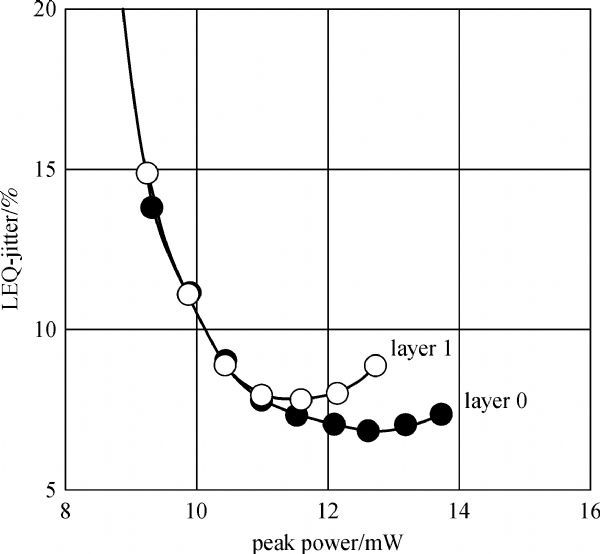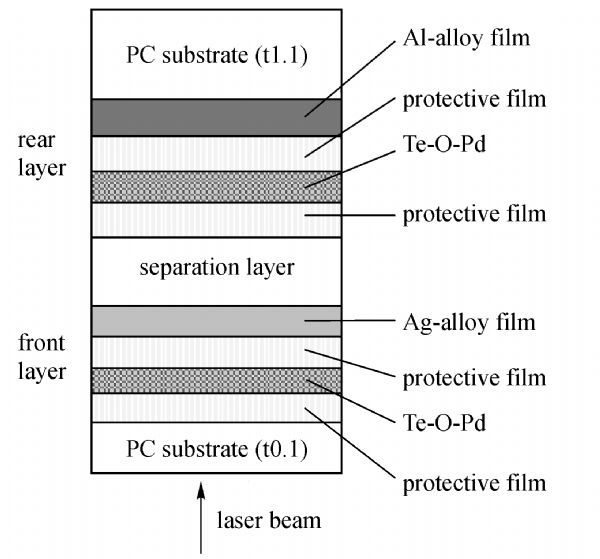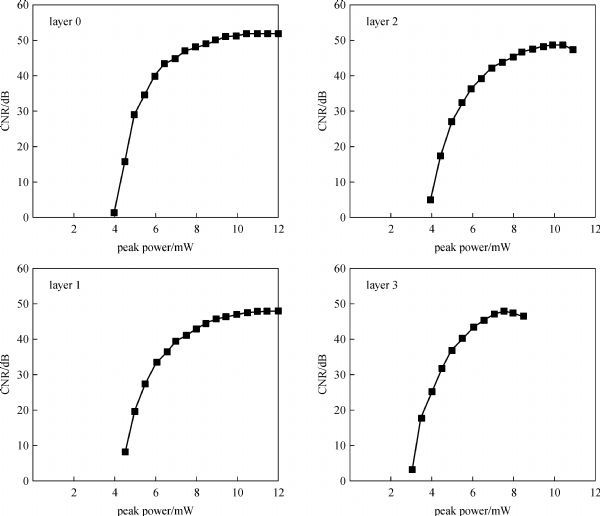AVC Networks Company, Panasonic Corporation, Kadoma, Osaka 5718501, Japan
miyagawa.naoyasu@jp.panasonic.com
IntroductionBlu-Ray DiscTM (BD) media and drives have been already established for recording and distributing the high-definition audio and video (AV) contents and large volume personal computer (PC) data. The share of BD recorders per shipped ones in 2012 reached to 96% in Japan. This is because the benefits of BD, such as high capacity, compatibility, and usability, etc, are accepted for consumers. Until now, there have been many efforts on developing new technology on BD media and drives as well as contents promotion with Hollywood studios. As of today, commercialized rewritable/recordable BD media are 25, 50, 100 and 128 GB shown in Table 1. As clearly shown in the name of B D, the ‘disc’ is the prime key component of the system. As one of researchers involved in developing BD media from early days, the author is reviewing the technology of BD recordable/rewritable media in this paper.
Tab.1
Tab.1
 Tab.1 Types of commercialized BD media| capacity recording speed | rewritable | recordable |
|---|
| single layer | 25 GB1X–2X | 25 GB1X–6X | | dual layer | 50 GB1X–2X | 50 GB1X–6X | | triple layer | 100 GB1X–2X | 100 GB2X–4X | | quadruple layer | – | 128 GB2X–4X |
| Tab.1 Types of commercialized BD media |
Optical disc system with blue laser and high-numerical aperture objective lensThe development of optical recording media has a long history, but before appearance of BD, those successful worldwide media were only compact discs (CDs) and digital versatile discs (DVDs). Compared with other optical discs, the BD system is characterized by using blue wavelength laser, high numerical aperture (NA) objective lens for the optical head and thin cover layer for the disc as shown in Fig. 1. Following data recording on such conventional media, researches on antecedents of BD media were started in the early 1990s when they found a potential for high density recording by laser light with shorter wavelength.
In 1991, Hashimoto et al. succeeded to write 0.3-μm-length marks by the blue light with the wavelength of 488 nm, which were much smaller than those by the infrared radiation (IR) light with the wavelength of 780 nm [ 1] . The blue light was emitted from Ar-laser and its intensity was modulated by acoustic-optical (A-O) modulator to create the sub-micron marks shown in Figs. 2 and 3. However, the derived signal to noise ratio (C/N) from the blue optics during reading of the marks was far from feasible because there was loss in the photo detector sensitivity at 488 nm compared to that at 780 nm. This means we had to wait the improvement of a photo detector. Although this experiment was performed with magneto-optical discs which used the different recording material and mechanism from present BD media, this is the first report on blue laser light recording. While Mizuno et al. reported the first blue laser recording with phase change discs in 1992 [ 2], they confirmed that 0.3-μm-length marks were clearly formed on the recording films made of GeSbTe which is practically same composition system as that of present BD rewritable (RE) discs. In spite of such achievements was done in the early 1990s, practical blue laser recording system has not established until the end of the century when the semiconductor laser diode with wavelength of 405 nm was ready in the production line.
The origin of high NA optics for BD system is probably attributed to the solid emersion lens (SIL) proposed by Mansfield et al. in 1993 [ 3]. The original concept was data storage by high NA optics near field light using SIL shown in Fig. 4. The effective NA of their objective lens is 1.05, which means it utilized near field light to detect the sub-micron length marks on the optical discs. At that moment, they only proved the improvement of optical resolution by retrieving the scanning microscopic image using read-only type optical discs. Because the SIL was not supposed to have enough tolerance in manufacturing the optical pickup head for commercial use, Yamamoto et al. proposed an optical system with an NA of 0.8, i.e., lower NA than SIL but higher than DVD in 1997 [ 4]. Its optics has a combination of two objective lenses and thinner incident substrate for optical disc shown in Fig. 5, so the entire system has enough working distance and tolerances to be suitable for commercial market like video player/recorders as described in Table 2. In addition, this lens system has an advantage of compensating the spherical aberration caused by the difference in thickness of incident substrate of optical discs by controlling the distance between the two lenses. It also enables compatibility with conventional optical discs like CD/DVD and double which have thicker incident substrate. The thin incident substrate of the disc is the third key technology of BD which contributes the wide tolerance in mechanical configuration of the optical pickup head and disc same as CD/DVD’s. Actually, the incident substrate of 0.1-mm-thickness is called a cover layer in the later BD specifications.
Tab.2
Tab.2
 Tab.2 Specifications of the two-element lens [ 4]. Copyright 1997, The Japan Society of Applied Physics| parameter | value |
|---|
| wavelength | 680 nm | | NA | 0.8 | | focal length | 2.47 mm | | working distance | 75 μm | | disk substrate | 0.1 mm | | distance between two lenses | 0.946 mm | | lens 1 | radius | 1.25 mm | | thickness | 1.40 mm | | index n | 1.514 | | lens 2 | NA | 0.45 |
| Tab.2 Specifications of the two-element lens [ 4]. Copyright 1997, The Japan Society of Applied Physics |
As for the last features of BD format, 0.1-mm-thick cover layer was at first reported in 1997 in order to decrease the coma-aberration due to disc tilt which was critical when high NA of objective lens is introduced to optical disc systems. But as you can expect easily, it was skeptical that such a thin cover layer could be manufactured stably with enough feasibility and fast machine cycle like a 0.6-mm-thickness substrate of DVD. In 1999, Decré and Vromans experimentally demonstrated that two techniques allow the manufacture of a 0.1-mm-thick cover layer for single layer BD media within the requirements of BD system [ 5]. The first method used spin-coating of an UV curable resin and the second method was the UV bonding of a 0.1-mm-thick polycarbonate sheet. Both techniques guaranteed the thickness variation and birefringence within the single disc, as shown in Fig. 6. The spin-coating was established in the manufacturing process of CD-R and DVD-R for application of organic dyes material so that it was expected to be low cost, while the UV bonding of a 0.1-mm-thick polycarbonate sheet leaded to rather higher cost. Therefore, few manufactures have adopted the latter technique nowadays.
Rewritable media for Blu-Ray DiscTM system As a DVD market started to grow in the end of 1990s, researchers started to pay attention to the next generation of the optical disc specifications including writable media. Because the DVD-movie has just launched after tough negotiation among many CE/IT companies and movie studios, the first proposals of BD-type system was based on the rewritable media for video recording application, which CE companies can take an initiative in that field. In 1999, Ichimura et al. proposed an optical disc system for digital video recording, which employed optical pick-ups with blue laser diode ( λ~400 nm) and high NA ( = 0.85) objective lens and phase change disk with thin ( = 0.1 mm) cover layer [ 6]. This combination of parameters was exactly conformed to the present BD specifications, but at that time they called this type of optical disk system as DVR (digital video recording) format. The phase-change disk comprises 6 thin-film stacks with Si-C crystallization promoting layer in order to achieve high transfer rate and optimized thermally and optically for the optical parameters, as shown in Fig. 7. Then it leaded to demonstrate the capacity of up to 25 GB and the user data transfer rate of 27 Mbps with enough overwrite cyclability, as shown in Fig. 8. It should be notified that digital data were recorded on both groove and land tracks in the DVR format, whereas the BD formats later adopted only grooves as recording tracks.
Another feature of BD format is dual recording layers per side for rewritable media, which enables doubling the recording time without flipping the disc. Actually, the first experimental demonstration on the rewritable disks with dual recording layers was performed based on the DVD format with red laser diode ( λ~650 nm), NA (= 0.6) objective lens and 0.6-mm-thickness substrate in 1997 [ 7]. Until then, there was no experimental report on that technology, whereas there were some reports on ROM type and write-once type. They developed a high transmittance first medium featuring a very thin recording film and no reflection film, and a high recording sensitivity and high reflectivity second medium with a reflection film shown in Fig. 9. As the results, they obtained equivalent signal amplitude and recording sensitivity from the moth recording layers, as shown in Fig. 10. In 1999, Akiyama et al. reported the rewritable optical disk with dual recording layers utilizing blue-violet laser [ 8]. Although this report did not exactly match with the BD formats in NA and thickness of cover layer, they have carefully investigated the recording material and stuck structure suitable for dual recording layers, as shown in Fig. 11. The phase change material for both recording layers are made of GeSbTeSn, i.e., a nuclear dominant material, in which the crystallization at the erasing process occurs from nuclei created by laser heating in the amorphous mark. Thus, this material is in principal disadvantage for the dual recording layer, which shall be thin due to requirement of high optical transmission resulting in decrease of nuclei for crystallization. The value of this report lies in the design process where the composition of the phase change material suitable for thin recording film of the first medium and the stuck structure with sufficient absorption for high sensitivity of the second medium were logically derived and the demonstration of the feasibility. In 2001, at last, Kurokawa et al. demonstrated a 41.8-GB double-decker phase change disc using optical parameters of BD, i.e., blue laser, NA of 0.85 and cover layer of 0.1 mm, as shown in Fig. 12 [ 9]. They introduced the phase change recording material made of AgInSbTe called as nuclear growth dominant material, in which the crystallization at the erasing process occurs from the boundary between the amorphous mark and surrounding crystalline region by laser heating. Thus, this material was regarded advantageous for thin recording film that has still boundaries for high-speed crystallization enough to realize high-definition video recording.
The main issues of dual layer optical discs are the change in transmittance of the first medium by recording procedure and how to stuck two recording layers on one side of a disc substrate. The change causes the variation in reflectivity and recording sensitivity of the second layer. In 2001, Narumi et al. developed a rewritable dual-layer phase-change optical disk with a balanced transmittance structure [ 10]. In this disk structure shown in Fig. 13, transmittance of the layer located at the laser beam incident side ( = the first medium) was almost constant whether the layer is recorded or not. This structure was realized by adopting Ge-Sb-Te film that has appropriate optical constants, and optimizing the thickness of dielectric layers. Actually, the availability of the balanced transmittance structure strongly depends on the composition the phase change materials, as shown in Fig. 14. They concluded that Ge-Sb-Te and Ge-Sn-Sb-Te films have optical constants that are essentially easy to design the balanced transmittance and suitable for a dual-layer optical disk. As for the capacity, 50 GB for dual layers was achieved with above recording material by introducing the write pulse strategies optimized for each recording layer to compensate the difference in thermal condition of the two layers. In 2001, Hayashi et al. proved the spin-coating technique was applied to dual layers BD media utilizing two kinds of resin that adhesive and replicating functions were assigned separately to form a space layer with thickness of 25 μm between the first recording layer and the second recording layer [ 11]. The adhesive resin is coated on top of the first recording layer with 1.1 mm substrate with pre-grooves for the first recording layer. While, the replicating resin is coated on top of the plastic stamper-substrate with pre-grooves for the second recording layer and both surfaces of resin were stacked each other. After UV-curing of the adhesive resin, only the stamper substrate was peeled so that the pre-grooves for the second recording layer were replicated on the space layer. This process was a little bit complicated but proved to be enough feasible for mass-production later.
After above technological improvement and foundation of organization for creating the BD rewritable formats, a single layer (SL) BD rewritable medium and a recorder for 23 GB capacity were shipped into the Japanese market for the first time from Sony in 2003. Then, next year, SL and dual layer (DL) BD rewritable media and a recorder for 25 and 50 GB capacities were put on the market from Panasonic. The difference in the capacities of the SL discs comes from that of their minimum recording mark length, i.e., 0.160 μm for 23 GB and 0.149 μm for 25 GB, while the recording track pitch as on-groove recording is 0.32 μm for both cases. Although these were the first CE products to record the high-definition TV programs, the amount of shipment was limited due to their relatively prices. The fact that the first BD media were packed in the cartridge might be another reason for the negative market result. The explosion of BD market had to be waited until the development of the next generation. In addition, a recording speed is very important from the viewpoint of buck-up procedure from hard drive to BD media. That of the above technological reports and products were almost ~35 Mbps, which was correspondent to 1X speed of high definition TV program for home video. So, higher recording speed was needed for the next version of the BD format.
In 2000, Inoue et al. reported that they developed an SL BD rewritable medium with a user data recording rate of 70 Mbps, i.e., 2X-BD speed, by designing a highly flat cover layer, a recording layer having high crystallization speed and a film structure for rapid cooling, as shown in Fig. 15 [ 12]. Because the rewritable media adopted a phase change material, for higher recording speed, both the higher crystallization speed for erasing the pre-recorded amorphous marks and the rapid cooling for forming new amorphous marks are necessary. They solved the former issue by the recording film of AgInSbTeGe and the latter issue using an Al2O3 protective layer with high thermal conductivity then obtained good overwrite characteristics, as shown in Fig. 16. They also reported in 2001 that they improved that structure and achieved a recording speed of 140 Mbps ( = 4X) in 2001 [ 13]. They introduced a modified rapid cooling disc structure and write strategy for 4X-speed, as shown in Figs. 17 and 18. As for a DL BD rewritable medium, Nishihara et al. demonstrated the 2X-speed dual-layer BD (72 Mbps) applying new film-stuck structure with compound type material films in 2003 [ 14] .The new material enabled the 2X-speed record-erase performance and good jitters of reproducing signal with maintaining the balanced transmittance, as shown in Figs. 19 and 20. However, 4X-speed dual-layers BD has never been reported so far probably because of the difficulty in maintaining enough erase ratios with thin phase change films for layer 1.
Recordable (write once) media for BD systemAs described above, BD media were developed in terms of rewritable disc in order to replace video cassette tapes. However, when the BD rewritable discs were put into the market, write-once type discs like CD-R and DVD-R were more popular than rewritable type discs. Thus, it was expected that write-once media for BD system should be developed and their formats should be specified.
In 2002, there were two reports about write-once discs conforming to the BD specifications. Inoue et al. reported an inorganic write-once single-layer disc with the recording films of copper alloy and silicon, as shown in Fig. 21 [ 15]. The area heated by laser beam during data-recording is melted and two films are mixed and recording marks are formed. They demonstrated the hi-speed recording up to 144 Mbps (4X-speed) with this media by means of write pulse strategy with high bias power, as shown in Fig. 22. Hosoda et al. also reported recordable type disc for BD system with a recording film of bismuth germanium nitride as shown in Fig. 23 [ 16]. They explained the high modulation of recording signals depends mainly on the reflectivity change of the recording material caused by the decomposition of nitride. By heating with a laser beam Bi-N is decomposed into the bismuth metal and nitrogen gas and recording marks are formed with tiny babbles of the nitrogen gas. While, Ge-N is not decomposed so that it prevents the heat diffusion outside of the recording marks and the deformation of recording film. In the end, they can obtain a well-formed minute mark and wide margins for write peak power as shown in Fig. 24.
In 2003, Uno et al. have developed 50 GB dual-layer write-once media with Te-O-Pd based recording films, as shown in Fig. 25 [ 17]. The recording mechanism was that Te-O-Pd based films were not crystallized directly through solid process, but crystallized through melting. This means once the film is heated to melting point, crystallization can occur rapidly in that Te-O-Pd based materials are suitable for high-density and high-speed write-once media on the BD format. The authors successfully demonstrated the feasibility of writing at 1X–4X speed on the media, as shown in Fig. 26.
The popular application of write-once media is back-up storage of PC data and TV programs, the writing/recording speed is the most interested feature for users. Thus, manufacturers compete in the speed to appeal their products. In 2005, Furumiya et al. reported high-speed data recording at a channel bit rate of 528 Mbps ( = BD-8X) using the available recording techniques [ 18]. By applying an L-shaped write strategy with a laser pulse of 0.7 ns rising time to conventional BD recordable media with Te-O-Pd recording material, as shown in Figs. 27 and 28, they concluded that it would be effective for higher-speed media to utilize a more rapidly cooling structure by modification of the dielectric or reflective layers. In the same year, Minemura et al. demonstrated write/read techniques and test results for 1X to 12X speed on single layer BD [ 19]. The key technologies were a multiplexer (MUX)-type write pulse generator, an adaptive partial-response maximum- likelihood (PRML) method, a new write adjustment method and newly developed phase-change write-once disc, as shown in Fig. 29. They installed MUX chips for optical communication devices to control the write pulses with an accuracy of less than 100 ps. The adaptive equalizer was used to recover the signal distortion including the degradation in the resolution. A mono-pulse strategy with two power levels was used for>8X-speed and mark edge control against thermal interference was solved using 4 × 4 tables of starting time of first pulse and ending time of last pulse. The medium was composed with a phase change recording film and anti-crystallization film to prevent from over-writing of 1st-written data. As a result, the limit equalizer jitters of less than 6% and power margins of more than ±10% were obtained and its feasibility was proved satisfactory, as shown in Fig. 30.
After waiting for the completing of development on 2X-speed recordable and recordable discs, 2nd generation of BD specifications were released in 2006 and the first products of BD recorder, PC drives, 2X-speed BD rewritable and recordable media were shipped from Panasonic. The additional feature of the 2nd generation BD other than 2X-speed was a cartridge-free. In the case of the 1st generation BD, disc cartridge was mandatory because the system is sensitive to scratches and fingerprints on the disc surface adopting the thin light-transmitting layer (0.1 mm). Moreover, a shorter working distance results in a higher risk of pickup hits onto the disc surface due to the high NA of the lens. To realize a bare disc for BD media, Hayashida et al. proposed a hard coat made of UV-curable acrylic resin and nanoparticles of silica with lubricant that exhibits oil repellency as well as low friction coefficient, as shown in Fig. 31 [ 20]. The new hard coat showed good abrasion resistances, fingerprint removability and especially remarkable scratch resistance, as shown in Fig. 32. Thanks to removing the cartridge, BD media became more cost-effective and user-friendly products as same as CD/DVD media.
Triple and quadruple media for BD systemTriple and quadruple layer (TL/QL) write-once and rewritable BD media technologies were developed to store a huge capacity of data in order to meet a rapidly increasing demand for both professional usage and consumer production. For this purpose, the recording capacities per each layer were increased from 25 GB for SL and DL discs to 33.4 and 32 GB for TL and QL discs respectively. This improvement was realized by progresses of signal processing and media performance and resultant BD specifications are called BD-XLTM. However, the early developments of multi-layers BD media were performed on 100 GB for a QL write-once disc, though the capacities and numbers of layers for the present BD specifications are 100 GB for TL and 128 GB for QL discs.
The first report on the QL write-once medium was disclosed in 2001 by Kitaura et al. [ 21]. The medium consisted of Te-O-Pd phase-change recording film and ZnS dielectric films for three layers of a laser-incident side and additional Al-Cr reflective film for a back side, as shown in Fig. 33. They demonstrated that it showed well-balanced reflectivity, recording sensitivity and high CNRs for the minimum mark length enough at BD-1X recording speed to achieve a recording capacity of 90 GB, as shown in Fig. 34. Although this was not equivalent to the capacity of the later official BD format, the report is valuable in that it indicated the possibility of multiple recording layers write-once disc for the first time. In 2003, Mishima et al. succeeded to develop an inorganic write-once QL disc with for then BD system [ 22]. Using ZnSiMg-O-S (ZSMOS) recording film with high-transmittance for front three layers and Si/Cu alloy recording film for back-side layer, as described in Fig. 35, they obtained the reflectivity and jitter values for each recording layer enough to prove the possibility of a 100 GB-QL disc, as shown in Table 3.
In 2006, Ichimura et al. investigated the improvement of capacity per layer by employing both an adaptive equalizer and new partial-response maximum-likelihood (PRML) detection method, i.e., PR12221ML [ 23]. As a result, the possibility of a storage capacity of 33.3 GB per layer was confirmed using a QL BD-R disc made by TDK Corporation. Thanks to their careful investigation of coherent interlayer crosstalk and optimization of each spacer thickness (See Fig. 36) as well as reflectivity for mitigating signal deterioration originated in internal multiple reflections, measured bERs increased only moderately from those in single-layer recording and presented sufficient tilt margins, as shown in Fig. 37. These technologies became basis of BD-XLTM specifications later.
Tab.3
Tab.3
 Tab.3 Reflectivity and jitter value of each layer [ 22]. Copyright 2003, SPIE| layer | reflectivity/% | jitter/% |
|---|
| layer 0 | 5.6 | 9.7 | | layer 1 | 5.2 | 9.5 | | layer 2 | 5.9 | 8.3 | | layer 3 | 5.0 | 9.6 |
| Tab.3 Reflectivity and jitter value of each layer [ 22]. Copyright 2003, SPIE |
As for multi-layers rewritable BD media, two reports were presented in 2009. First, Nishihara and Nakamura et al. developed a TL rewritable medium with a very GeTe-rich GeSbTe film and a newly developed TiO2-based dielectric film having a high refractive index, as shown in Fig. 38 [ 24, 25]. They optimized the material composition of the recording film as maximizing crystalline temperature and optical change for recording with keeping a sufficiently short crystallization time enabling 2X-speed overwrite. The TiO2-based dielectric film contributed to the high transmittance of the front layers (layer 1, layer 2) even if they are provided with Ag alloy film. As the results, a symbol error rate (SER) of every layer reached less than 1×10-4 , as shown in Fig. 39. Secondly, Shingai et al. developed a TL rewritable disc on the base of BD systems using a Mn-Sb-Te-Ge phase-change material, as shown in Fig. 40 [ 26]. The features of the Mn-Sb-Te-Ge phase-change material were the high crystallization speed and high thermal stability of amorphous marks enough for 2X-speed writing/reading. The N/2 write strategy was set at a long cooling pulse period and realized the formation of amorphous marks of sufficient size. As a result, a sufficient SER and a high read stability were achieved, as shown in Fig. 41.
In 2011, the TL/QL BD-recordable discs and the TL BD-rewritable disc were finally manufactured for consumer market by TDK and Panasonic and for professional market by Sony. The reason why TL rewritable media was developed so late compared to TL/QL recordable media and QL media were not achieved for rewritable discs, is mainly because the transmittance of rewritable recording layer is much lower than that of write-once recording layer. It is caused by the metal heat sink film which is mandatory for the rapid cooling stuck structure to create amorphous recording marks in phase change recording materials.
As for the effort to improve the recording capacity more than present BD-XLTM media, there have been many reports so far. Lee et al. reported the results of new reproducing scheme including the signal waveform phase detector [ 27]. They achieved a high linear recording density corresponding to 45 GB per layer and gave a hint to reach a capacity of 50 GB. Ishihara et al. developed the inter-track crosstalk canceling PRML decoder with phase compensation which reproduced the readout signal on a disc with the track pitch of 0.24 μm in 2011 [ 28]. They expected to achieve an optical disc with 44 GB capacity a layer. Takahashi et al. presented that a capacity of more than 50 GB/layer was feasible with the conventional BD optical parameters and improved recording stacks, assuming PR(2,3,3,3,2)ML method and adoptive cross talk canceller with adaptive equalizer in 2011 [ 29]. Mikami et al. reported a 20-layer optical disc with two-photon recording layers using web coating and lamination for the high-throughput production of multilayer optical discs in 2012 [ 30]. Although these reports showed remarkable progress in recording capacity of BD media, the possibility to emerge such new generation discs seems to depend on the market demands.
ConclusionsHistory of the technology on BD rewritable/recordable media for more than 20 years has been reviewed. As described above, the writable BD media had been developed for consumer use like video-recording/PC buck-up and professional use likes broadcasting. For these purpose, present BD discs and systems are considered to be, as it were, the final version of optical disc. However, in spite of many technological efforts to satisfy user demands, the market size of BD media/devices is held in check these days due to the spread of internet delivery of video programs and rapid cost down of hard drives. While, some reports insist that digital archiving by optical discs like BD media can prepare for explosion of digital data as a promising application in the near future. It is believed that BD media still have a large potential enough to contribute to world-wide users benefit with many aspects.
